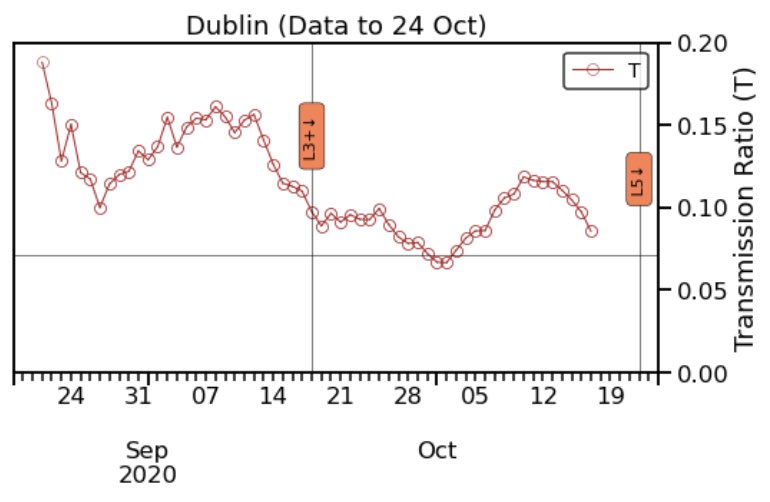
Now that we are closing in on the end of October there is an opportunity to look back at the data from Ireland’s Level 3 restrictions to determine: was it working; why we needed to move to L5; and what this means for the future.
(1/12)
link.medium.com/Wj7KAIHpXab
(1/12)
link.medium.com/Wj7KAIHpXab
Here's the county transmission picture from Oct 7, at the start of L3. We want to be in the lower-left quadrant (low & falling transmission rates) but counties are mostly spread across the upper-right (high and rising transmission rates). Not good.
(2/12)
(2/12)

However, by Oct 18 things had improved, at least in the sense that transmission rates were falling. Most counties were on the right trajectory now. Good but with room for improvement. But if L3 was working why then the need to move to L5?
(3/12)
(3/12)

Although most counties were heading in the right direction, progress was slow and sometimes inconsistent. Eg, Dublin's transmission rates (below) had begun to rise during L3. If it happened in Dublin it could happen elsewhere too. L3 didn't fail us, we failed L3!
(4/12)
(4/12)

So here we are in L5, which is especially frustrating since most of us feel we have been doing everything that has been asked of us for months. Is it really the case that to bring transmission down we need a full lockdown? Is this our future? Perhaps not ...
(5/12)
(5/12)
A characteristic of this virus is that it's transmission is unevenly distributed. This is called overdispersion, and it is superbly discussed by @zeynep of @TheAtlantic in theatlantic.com/health/archive…
(6/12)
(6/12)
Seasonal influenza is more or less evenly transmitted but SARS-CoV-2 is not, so its R num only tells part of the story. It is why we have superspreading events.
Overdispersion can make it hard for the virus to take hold but when it does it can really explode.
(7/12)
Overdispersion can make it hard for the virus to take hold but when it does it can really explode.
(7/12)
For SARS-CoV-2, 80% of cases can be caused by 10% of individuals this may be why, in part at least, we have not been successful in controlling it of late and why we are in L5 today, even though most people have been diligently observing the guidelines for months.
(8/12)
(8/12)
If 80% of cases can be produced by 10% of individuals, then it’s not enough for a majority follow the guidelines, because the small minority who don't can generate a disproportionate number of cases.
The good deeds of the many can’t make up for the misdeeds of the few.
(9/12)
The good deeds of the many can’t make up for the misdeeds of the few.
(9/12)
This also has implications for contact tracing. Instead of tracing the close contacts of a newly infected case, from the time of their infection (forward tracing), we should identify the original source of the newly infected case (backward tracing) & work from there ...
(10/12)
(10/12)
@AdamJKucharski discusses how this backward tracing approach can help to identify 3-10x as many infections and avert 2-3x as many new cases, compared with more conventional forward tracing; see wellcomeopenresearch.org/articles/5-239
(11/12)
(11/12)
In the article below I discuss these matters and more, including some concrete suggestions for how we might plan to exit L5 safely ... for good this time!
(12/12)
link.medium.com/Wj7KAIHpXab
(12/12)
link.medium.com/Wj7KAIHpXab
• • •
Missing some Tweet in this thread? You can try to
force a refresh








